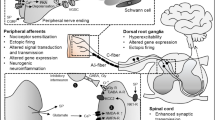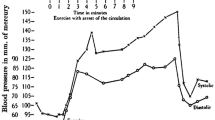Summary
Polyneuropathy is a frequent complication in diabetics. In a nonselected group of 65 diabetics, 30 patients had clinical signs of neuropathy. These patients had more significant changes in electrophysiological parameters than patients without clinically evident polyneuropathy. Significant reduction of sural nerve conduction velocity was observed in 16 of 30 patients with and in 4 of 35 diabetics without clinical signs of polyneuropathy. Additional information was obtained when paired stimuli were applied and the test response latency was measured. Stimulus intervals of 3 ms gave the highest quota of information about involvement of the sural nerve. Significant prolongation of the test response in paired stimulation at intervals of 3 ms was found in 21 of 30 patients with clinically apparent diabetic polyneuropathy and in 16 of 35 diabetics without clinical signs of polyneuropathy.
Zusammenfassung
Polyneuropathie ist eine häufige Komplikation des Diabetes. Es wurde eine nicht selektierte Gruppe von 65 Diabetikern untersucht, von denen 30 Patienten klinische Zeichen einer diabetischen Polyneuropathie hatten, die übrigen 35 Patienten hatten keine derartigen Hinweise. Bei Patienten mit klinischen Zeichen einer Polyneuropathie waren Veränderungen elektrophysiologischer Parameter häufiger als bei Patienten ohne klinisch eindeutige Hinweise auf eine Beteiligung des peripheren Nervensystems. Für die Identifizierung einer diabetischen Polyneuropathie wurde eine signifikante Verminderung der Leitungsgeschwindigkeit des N. suralis bei 16 von 30 Patienten mit klinischen Zeichen einer Polyneuropathie gefunden. Aber auch bei 4 von den 35 Patienten ohne klinische Zeichen einer Polyneuropathie lag die Leitungsgeschwindigkeit unterhalb des 95%-Vertrauensbereiches. Zusätzliche Informationen konnten durch Doppelstimulation des N. suralis und Registrierung der Latenz der konditionierten Antwort gewonnen werden. Reizintervalle von 3 ms gaben die höchste Treffquote einer signifikanten Verlängerung der Latenz der konditionierten Antwortpotentiale. Diese Latenzverlängerung nach einem Reizintervall von 3 ms wurde bei 21 von 30 Patienten mit klinisch nachgewiesener diabetischer Polyneuropathie gefunden. Auch bei 16 von 35 Diabetikern ohne klinische Zeichen einer Polyneuropathie war diese Latenz signifikant verlängert.
Similar content being viewed by others
References
Behse F, Buchthal F (1971) Normal sensory conduction in the nerve of the leg in man. J Neurol Neurosurg Psychiatry 34:404–414
Bischoff A (1965) Die diabetische Neuropathie. Praxis 54:723
Buchthal F, Rosenfalck A (1966) Evoked action potentials and conduction velocity in human sensory nerves. Brain Res 3:1–122
Chopra JS, Hurwitz LJ, Montgomery DAD (1969) The pathogenesis of sural nerve changes in diabetes mellitus. Brain 92:391–418
Dahl K, Buchthal F (1978) Digital memory recorder in electromyography and nerve conduction studies. Clin Neurophysiol Electromyogr 45:538–544
Gilliat RW, Willison RG (1962) Peripheral nerve conduction in diabetic neuropathy. J Neurol Neurosurg Psychiatry 25:11–18
Lamontagne A, Buchthal F (1970) Electrophysiological studies in diabetic neuropathy. J Neurol Neurosurg Psychiatry 33:442–452
Lehmann HJ, Tackmann W (1970) Die Übermittlung frequenter Impulsserien in demyelinisierten und in degenerierenden Nervenfasern. Arch Psychiatr Nervenkr 213:215–227
Lehmann HJ, Muche H, Schütt P (1977) Refractory period of human sural nerve action potential related to age in healthy probands. Eur Neurol 15:85–93
Schütt P, Muche H, Gallenkamp U, Lehmann HJ (1979) Reversible Funktionsstörungen peripherer Nerven bei Patienten mit Schilddrüsenerkrankungen. EEG EMG 2:101–105
Schütt P, Muche H, Lehmann HJ, Hielscher H (1980) Sural nerve conduction velocity and refractory period in diabetics without clinical signs of neuropathy. Hormone and metabolic research. Thieme Verlag, Stuttgart, pp 39–42
Tackmann W, Lehmann HJ (1974) Refractory period of human sensory nerve fibres. Eur Neurol 12:277–292
Tackmann W, Lehmann HJ (1980) Conduction of electrically elicited impulses in peripheral nerves of diabetic patients. Eur Neurol 19:20–29
Tackmann W, Ullerich D, Cremer W, Lehmann HJ (1974) Nerve conduction studies during the relative refractory period in sural nerves of patients with uremia. Eur Neurol 12:331–339
Thomas PK, Eliasson SG (1975) Diabetic neuropathy. In: Dyck P, Thomas PK, Lambert EH (eds) Peripheral neuropathy. WB Saunders, Philadelphia
Thomas PK, Lascelles EG (1966) The pathology of diabetic neuropathy. Q J Med 35:489–509
Trojaborg W, Sindrup HE (1969) Motor and sensory conduction in different segments of the radial nerve in normal subjects. J Neurol Neurosurg Psychiatry 32:354–359
Ullerich D, Schütt P, Wiermann H (1974) Verhalten der sensiblen Nervenleitgeschwindigkeit bei Schilddrüsenfunktionsstörungen. Nordwest Ges Inn Med 83:16
Williams IR, Mayer RF (1976) Subacute proximal diabetic neuropathy. Neurology (Minneap) 26:108–116
Author information
Authors and Affiliations
Rights and permissions
About this article
Cite this article
Schütt, P., Muche, H. & Lehmann, H.J. Refractory period impairment in sural nerves of diabetics. J Neurol 229, 113–119 (1983). https://doi.org/10.1007/BF00313450
Received:
Issue Date:
DOI: https://doi.org/10.1007/BF00313450




